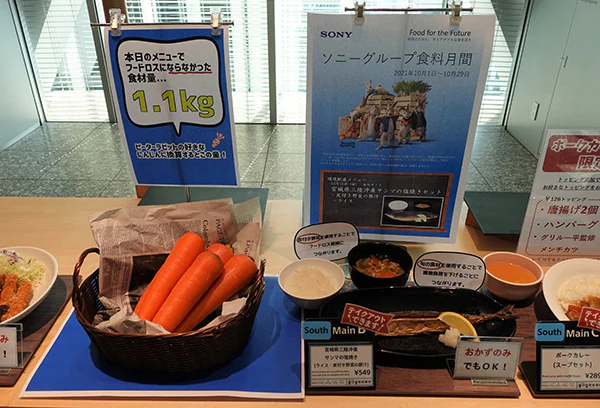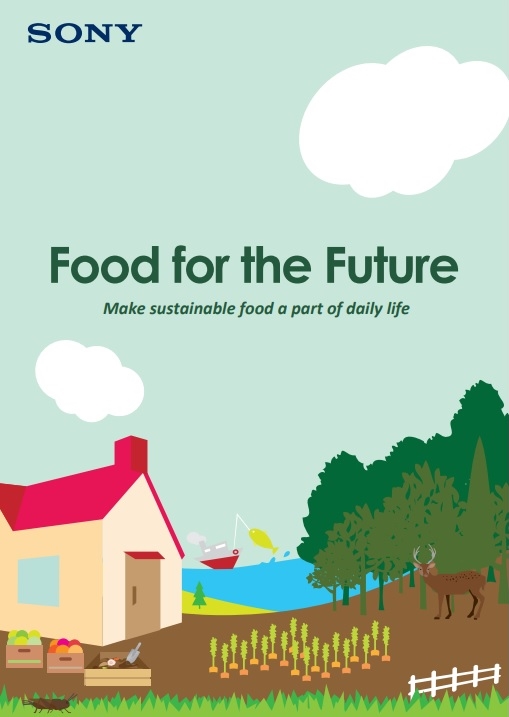Blog
Sony’s Food for the Future endeavors to change the way employees eat

Kozo Kawakita, Environment Section, Sustainability Department, Sony Group Corporation
Interviewer: Miho Soga
Introduction
Sustainable food is receiving more attention than ever. Globally, the EU and the environmental protection organization, WWF, have been advocating for sustainable food for several years. In the fall of 2021, Japan’s Ministry of the Environment also organized a discussion to exchange views on food and created a guide (in Japanese). A growing number of company cafeterias are also incorporating sustainable seafood and organic vegetables into their menus.
While most company initiatives focus on eating behavior at work, there are not many efforts to change the actual diets of employees. Meanwhile, Sony Group Corporation (Sony) is engaged in activities that don’t stop at the company cafeteria; in April 2021, the company launched its Food for the Future project and created a guidebook on eating habits for its employees.
To that end, we inquired about Sony’s efforts to change employee behavior around food and the creative approaches they use to promote their initiative.
Interview
Food for the Future – a project that shines with originality
I was surprised when I heard that Sony is getting involved with food. Why did you start the Food for the Future project?
Under our Road to Zero global environmental plan, which strives to achieve a zero environmental footprint throughout the life cycle of our products and business activities by the year 2050, Sony set environmental milestones every five years and take action with respect to the following four approaches: curbing climate change, conserving resources, controlling chemical substances, and promoting biodiversity. Food is a topic that is familiar to everyone and relates to environmental issues from these four perspectives.
Additionally, in the Green Management 2025 (GM2025), a medium-term environmental target spanning five years beginning in fiscal 2021, one of the goals identified in the area of biodiversity is to promote the use of environmentally conscious food in our company cafeterias and create opportunities to think about the environment by communicating the background for environmental issues.
Thus, in April 2021, we launched the Food for the Future project to encourage employees to eat more sustainably.
Environmental action from four environmental perspectives
Did the spread of COVID-19 impact your decision to take your efforts beyond the company cafeteria to create a guidebook for employees?
Indeed. At the outset of developing GM2025, we were mainly focusing on educational activities at the cafeteria, but due to the spread of COVID-19, offices were increasingly taking cafeterias out of operation. As a result, we decided to create the Food for the Future guidebook to help employees worldwide make environmentally conscious food choices in their diets while we continued our efforts at company cafeterias.
EcoNetworks assisted with the planning and production of the guidebook in Japanese and in English, but could you once again touch on what sort of thoughts and ideas were taken into consideration when developing its content?
For the guidebook, we chose content that would spur people into action, using illustrations to explain in simple terms the environmental issues linked with food, and what kinds of actions we can take to help. To point to specific actions, we also included explanations of ecolabels you might find at the store. We also valued accuracy and requested that all of the companies and organizations introduced in the guidebook verify its contents.
We want Sony’s employees around the world to look at it, so we made sure the content and design wouldn’t be awkward, no matter which country our employees are reading it from. Currently, we just have a Japanese and English version, but we would like to translate it into other languages. We plan to finish the Chinese version this spring.
Trying different approaches to get employees to read
How did you distribute the completed booklets, and how were they received within the company?
Initially, we published the PDF version of the guidebook online. We also created a printed version to distribute to all of our offices, and we have already passed out over 1,000 copies. Due to COVID-19, we haven’t had many opportunities to meet people directly in offices and hear their impressions, so it’s been a little difficult to gauge their response.
With these types of initiatives, many corporate managers rack their brains trying to figure out how to get people to read things. What kinds of things did you try to get employees to read this after it was completed?
We take advantage of events to plug the guidebook. Last year, in conjunction with World Food Day on October 16, the month of October was designated Sony Group Food Month, and menu items using environmentally conscious food were provided at cafeterias in each office. The guidebook was featured next to explanations of the menu to prompt people to pick up a copy after they were done eating.

Explanation of cooking vegetables with the skin on

Guidebooks staged for distribution
In Japan, we invited a lecturer from the UN Food and Agriculture Organization (FAO) to hold an internal webinar on the topic of protecting the environment through food. Employees joined from across Japan, and after this project was explained to them, they responded positively in a post-event survey that they wanted to use more environmentally conscious food.
Outside of Japan, in March of 2021, a group company in Singapore hosted an in-house webinar in which nutrition and wellness expert Caoimhe Smyth gave a talk on sustainable foods. Caoimhe is the founder of Fit Green Lean, which is based in Stockholm, Sweden. This was a program that could only have been done online.

Details of the webinar
I think it is important that those who call on others to engage in environmental activities enjoy doing the activities themselves. Are the members of the Environment Section doing anything related to sustainable food?
I personally am making a point to purchase and consume things like hamburgers with plant-based protein and cricket-based rice crackers whenever I come across them. My colleague who lives near the sea tries to eat locally by buying seaweed from that area. Many members practice vegetable gardening – some try to grow without pesticides while others raise fruit trees and make jam out of what they harvest. Outside Japan, there is a Malaysian employee who grows mangos for consumption.
When setting out to create the guidebook, I wanted to collect case studies from other countries. I emailed my counterparts living in countries other than Japan, and many of them shared websites related to sustainable food. I hope to continue exchanging information with colleagues interested in this topic to grow our company’s sustainable food community.
Expanding the reach of activities through internal collaboration
Sony has other efforts related to sustainable food aside from Food for the Future. Tell me about those efforts and how you have been collaborating on them.
At Sony Computer Science Laboratories, Inc. (Sony CSL), we are researching and implementing Synecoculture, an approach in which an ecosystem is artificially created to produce useful plants that enables us to harvest food while enriching biodiversity. With Synecoculture and other augmented ecosystems, it is possible to enhance biodiversity and ecosystem functions beyond their natural state. This core effort related to sustainable food is also featured in the guidebook.
Synecoculture was introduced in the premises of Sony’s office in China as part of our sustainability activities in 2020 and we are expanding it on independent farms. At one of the offices implementing Synecoculture, we held a tasting event at the cafeteria to try the freshly picked vegetables. With about 2,000 onsite employees participating, it was a good opportunity to experience Synecoculture firsthand.

In June 2021, Sony Pictures Entertainment’s Peter Rabbit teamed up with FAO on a popular campaign to increase food heroes. This is part of the GM2025 objective to use entertainment and other media to encourage over 2.5 million people to engage in environmental activities.
For this project, we collaborated to show a short film in company cafeterias and featured an image from the film on the cover of a corporate guidebook.
Also, we have Sony Startup Acceleration Program (SSAP), which aims to support the creation and business operations of startups. The program hosts the SSAP Idea Contest (in Japanese), and the Sustainability Department served as a judge for this year’s submission theme, food tech.
It’s great that through collaboration, opportunities to get the word out about Food for the Future will continue to develop both inside and outside of the company. To finish up, what are some ideas or things that you want to do going forward?
The spread of COVID-19 has resulted in a limited number of employees going into the office, so it is harder to expand efforts at company cafeterias. Still, we are working with offices to come up with sustainable food menu items that will get chosen by even more employees.
I’d also like to continue holding webinars about sustainable eating. Our group companies outside Japan also plan and host them, and I’d like to take advantage of this type of opportunity to promote Food for the Future so more people inside and outside of our group will choose sustainable food.
After the interview
Based on my conversation with Mr. Kawakita, I gathered that the following four points are important when it comes to projects that attempt to foster employee behavior change.
- Give it your best effort while monitoring the situation
- Promote your project, but stay true to your company’s identity
- Expand your activities by collaborating with other internal efforts
- Enjoy the process yourself, and lead by example
Mr. Kawakita, who talked about this project with a smile on his face, certainly puts the fourth point into practice. I am excited to see where Food for the Future goes from here.



